Tasting Leelanau 2015
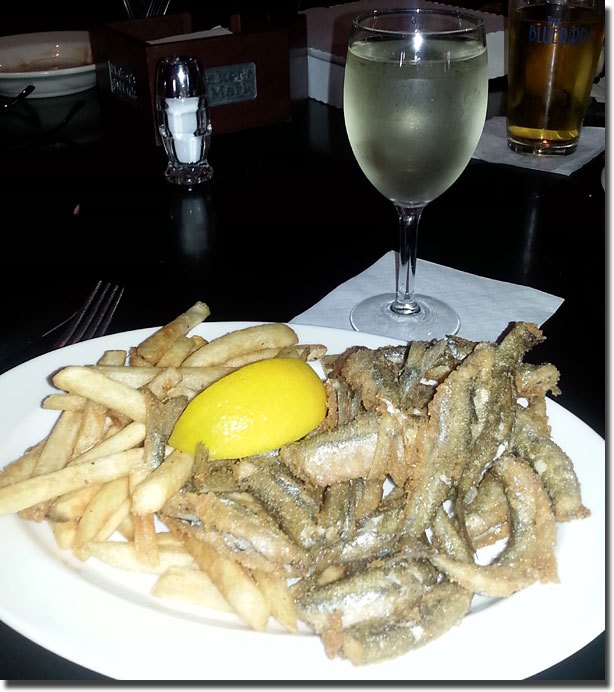 I just love hanging out in the little town of Leland, in Michigan’s Leelanau Peninsula. Straddling the 45th parallel and nestled between Lake Michigan and North Lake Leelanau, Leland is a picturesque community built on the site of the oldest and largest Ottawa village on the peninsula. I’ve had the good fortune and great pleasure to spend a few days there on two different occasions, the first during a musical road trip I took a few years ago. The second was the weekend of April 24-25, to participate in the Leelanau Peninsula Vintners Association’s Media Weekend, one of my favorite annual events. Add to that the fact that I had the opportunity to stop in for a plate of fresh smelt two nights in a row at The Bluebird Restaurant & Tavern, and it was all good. (Click images to enlarge.)
I just love hanging out in the little town of Leland, in Michigan’s Leelanau Peninsula. Straddling the 45th parallel and nestled between Lake Michigan and North Lake Leelanau, Leland is a picturesque community built on the site of the oldest and largest Ottawa village on the peninsula. I’ve had the good fortune and great pleasure to spend a few days there on two different occasions, the first during a musical road trip I took a few years ago. The second was the weekend of April 24-25, to participate in the Leelanau Peninsula Vintners Association’s Media Weekend, one of my favorite annual events. Add to that the fact that I had the opportunity to stop in for a plate of fresh smelt two nights in a row at The Bluebird Restaurant & Tavern, and it was all good. (Click images to enlarge.)
Our first encounter with the LPVA was in 2009, when Kim and I joined Master Sommelier Claudia Tyagi for a whirlwind three-day tour of Leelanau wineries, organized and sponsored by the association, that culminated with a brainstorming session with member wineries on sharing ideas on how they could use social media to spread the word about their burgeoning industry. Kim and I came back from that delicious experience with a far greater feel for what is happening in the Leelanau wine culture, and we like what we see and taste a lot. We’ve been attending the Media Weekend since 2012, and we relish the opportunity to get up close with growers and winemakers to taste and hear what they have to say about their wines.
Unfortunately, Kim could not attend this year’s festivities, so I soldiered on up myself. In the past three years, we requested accommodations in Traverse City. This year, I checked into The Leland Lodge, which turned out to be a much better location. I sacrificed access to a swimming pool for the chance to enjoy the company of old friends and meet and network with some new and very interesting folks.
This year’s Media Weekend was built around two events. The first was Friday night’s “The Five Ss with Michael Schafer, the Wine Counselor, held in the lodge. We’ve been friends with Michael and his wife Patty for several years, going back to our earliest MoCool days. He gave a “Wine 101” presentation that was as much fun as it was informative, using wines from LPVA producers. Two wines from that presentation would prove to be among the best of everything this taster encountered during the weekend, a lovely 2012 Bel Lago North Farm Pinot Noir, and a 2013 Shady Lane Blue Franc. Both offer further proof that Michigan is fully capable of producing excellent reds to go along with the Rieslings that we are so well known for and the sparkling wines that are so deserving of greater recognition.
The second event is actually a series of Saturday tours each year that focus on specific aspects of Leelanau Peninsula wine production. There were eight offered this year; I opted for “Range of Rieslings (Leelanau Rieslings from sweet to dry),” which proved to be a very good choice. I had the distinct pleasure of being one of a group of five that included Linda Jones, Program Manager of the Michigan Grape and Wine Industry Council, her husband and fish biologist Michael, Amy Sherman (@amyonthetrail), and Pam Gonzalez, wife of MLive Journalist John Gonzales, who was also in attendance, but on a different tour. (This troika also makes up the band of roving taste sensualists known as BehindTheMitten aka @BehindTheMitten.) I especially enjoyed hearing Linda’s insights throughout our day of touring; her 17 years with the Council has brought her a wealth of knowledge about so many aspects of our state’s wine industry.
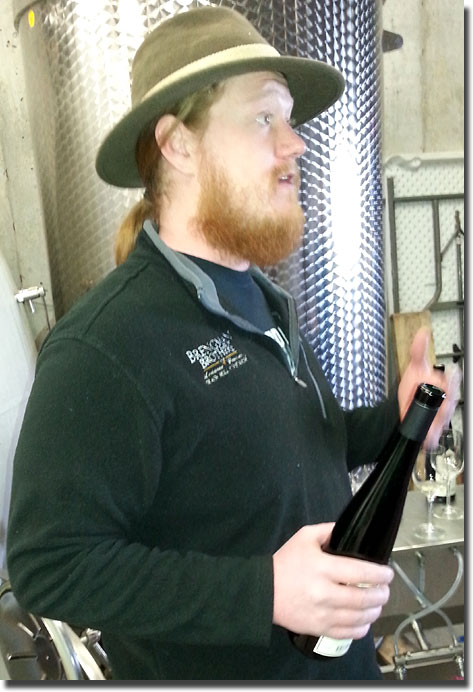 We started our tour at Brengman Brothers Winery, where we tasted with winemaker Nathaniel Rose. I had just blogged about two of their excellent whites the week previous, so I was really looking forward to trying their Rieslings, and wasn’t disappointed in the least. Nate says his wines aren’t market driven, he takes what the vintage gives him and makes the best of it, and these wines are very good indeed. (All tasting notes in this report are necessarily of the brief snapshot variety. Prices are listed when available.)
We started our tour at Brengman Brothers Winery, where we tasted with winemaker Nathaniel Rose. I had just blogged about two of their excellent whites the week previous, so I was really looking forward to trying their Rieslings, and wasn’t disappointed in the least. Nate says his wines aren’t market driven, he takes what the vintage gives him and makes the best of it, and these wines are very good indeed. (All tasting notes in this report are necessarily of the brief snapshot variety. Prices are listed when available.)
2013 Brengman Brothers Dry Riesling: Bone dry, tart and delicious, with good depth and body and classic varietal character. Find this wine
2014 Dry Riesling Tank Sample: Offers beautiful aromatics and tart, yet rich green apple and citrus flavors.
2013 Brengman Brothers Riesling Spatlese: Shows a delightful contrast of mineral and sweet fruit, with great acids. Find this wine
2013 Brengman Brothers Riesling Beerenauslese came in at over 26° brix, and weighs in at almost 14% residual sugar. Sweet, unctuous, complex and delicious. Find this wine
“The way you know a good Riesling is when it smells like opium and diesel.”
As once told to Nathaniel Rose by a friend.
As often happens in these situations, we strayed briefly from our Riesling mission to try a tank sample of the 2014 Brengman Brothers White Cabernet Franc. Very pale in color and very mineral driven, this is one I definitely want to try once it’s bottled. I left being an even bigger fan of Brengman Brothers and Nate’s winemaking than when we arrived.
 Our next stop was at Shady Lane Cellars, where we were hosted on the patio by Winemaker and General Manager Adam Satchwell, assisted by Tasting Room Manager Rick DeBlasio. I’ve known Adam and have been a fan of Shady Lane for several years, and last July, I was the first performer in their Summer Music on the Patio series. (I’ll be back this coming July 25th.) Adam feels that Riesling “is appropriate for this region,” and jokingly says that there ought to be a federal law mandating, “You must drink Riesling.” 24 of 50 estate acres are planted to the variety.
Our next stop was at Shady Lane Cellars, where we were hosted on the patio by Winemaker and General Manager Adam Satchwell, assisted by Tasting Room Manager Rick DeBlasio. I’ve known Adam and have been a fan of Shady Lane for several years, and last July, I was the first performer in their Summer Music on the Patio series. (I’ll be back this coming July 25th.) Adam feels that Riesling “is appropriate for this region,” and jokingly says that there ought to be a federal law mandating, “You must drink Riesling.” 24 of 50 estate acres are planted to the variety.
Adam started us off with his 2012 Shady Lane Cellars Sparkling Riesling ($21.95), which I am well acquainted with, and it shows pretty much the same as it did last summer. This was the only wine I did not spit during the day’s touring, which should tell you just how much I enjoy it. Find this wine
2013 Shady Lane Cellars Dry Riesling: Clean and crisp, with nice minerality and great balance of ripe fruit, sugar and acid. Green apple and lime zest. Jefferson Cup Winner. Find this wine
2012 Shady Lane Cellars Semi-Dry Riesling, $14.95: Pretty white lily and honeysuckle, peach and more obvious sweetness than the previous selection. Seamless transition from sweet fruit to acidity. Pacific Rim Wine Competition Gold. Find this wine
2013 Shady Lane Cellars Late Harvest Riesling: Adam waits to get what he refers to as “the brown flavors” before picking the grapes for this; it came in at 30° brix and has honeyed flavors balanced with some mineral and good acids. So yummy. Not yet released. Find this wine
Before heading out for our next appointment, we also got the opportunity to contrast the 2012 and 2013 Shady Lane Blue Franc, and while I didn’t take notes on these, both are quite tasty. As Adam told us back in 2009, Blue Franc is the literal translation of the German Blaufrankish, and can only be made from Lemberger, according to the ATF. Satchwell’s uncle Jed Steele trademarked the name for his Shooting Star label, and allows only Shady Lane to use it.
We were running late by the time we got to Forty-Five North Vineyard & Winery. We first learned about Forty-Five North during an enlightening ride around the peninsula with Chateau Fontaine’s Dan Matthies back in 2007. The facility was still under construction at that time, but it was obvious from appearances that the project was well-financed. They’ve come a long way in the eight years since then, as we found when we walked into the spacious brand new tasting room that wasn’t there when we visited last year.
Our tardiness didn’t faze the delightful Tasting Room Manager, Channing Sutton, who, upon seeing us enter, exclaimed, “Gang of Pour!” (Was it my hat…?) Channing can charm the birds out of the trees and she had me even before she handed us glasses of the 2013 Forty-Five North Fandango Dry Bubbly Rose, a hybrid blend of Frontenac Gris and La Crescent that explodes from the glass with effusive floral aromas, yet drinks quite deliciously dry. She led us down to the barrel room, where we found winemaker Jay Briggs (pictured below) and a table set for our intrepid band. Due to time restraints, and the fact that this was where we would have our lunch, I tried to listen to Jay’s presentation, take notes, shoot a little video and eat, all at the same time. I was probably most successful with my salad and sandwich, but did manage to scribble these few impressions.
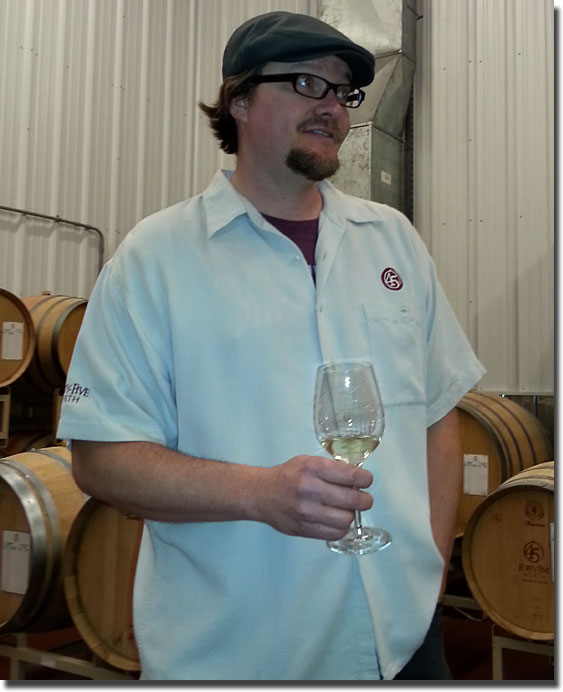 2013 Forty-Five North Riesling, $18: Lean and steely, Mosel-styled, which certainly works for me. Find this wine
2013 Forty-Five North Riesling, $18: Lean and steely, Mosel-styled, which certainly works for me. Find this wine
2014 Forty-Five North Riesling Tank Sample: Nice, but obviously still in the process of coming together.
2013 Forty-Five North Sweet Riesling: Excellent balance of sweet fruit and acid. Find this wine
2014 Forty-Five North Sweet Riesling Tank Sample: Because of the Polar Vortex winter of ’13-’14, the fruit for this came from the same Washington vineyard that Chateau Ste. Michelle and Ernst Loosen use for their Eroica Riesling. It’s a hint sweeter than the ’13, but the acids are lower. We all liked the ’13 better, but it’ll be interesting to try this finished product when it’s ready.
2013 Forty-Five North Riesling Ice Wine Old Mission Peninsula: Came in at about 40.2° brix. Wow! Huge honeyed aromatics follow through beautifully on the palate, with plenty of acidity. Find this wine
A quick aside on a point of great interest for me: Both Forty-Five North and Brengman Brothers employ an egg fermenter in their winemaking operations, shown below in the side-by-side graphic. These odd-ball looking contraptions seem likely to have a bright future in wine production here and elsewhere.
The first concrete egg fermenter was commissioned in 2001 by the French producer M. Chapoutier, and was made by French vat manufacturer Marc Nomblot, whose company has made traditional concrete vats since 1922. Concrete is porous, as is oak, so the wine is able to slowly aerate, or breath, adding richness and complexity. Obviously, the concrete eggs don’t add oaky flavors to the wine, but do add a subtle minerality, a desirable quality in crisp whites and roses, while retaining a lot of fruit character. The egg shape also facilitates circulation, due to a one degree temperature difference between the top and the bottom, with no dead corners. This in turn allows the wine more contact with the lees, or dead yeast cells, which release compounds such as amino acids, polysaccharides and fatty acids as they break down. Whether or not any other Michigan wineries are presently using egg fermenters, I can’t say, but I find it exciting that these two have taken the plunge, and seem to be getting very positive results from them.
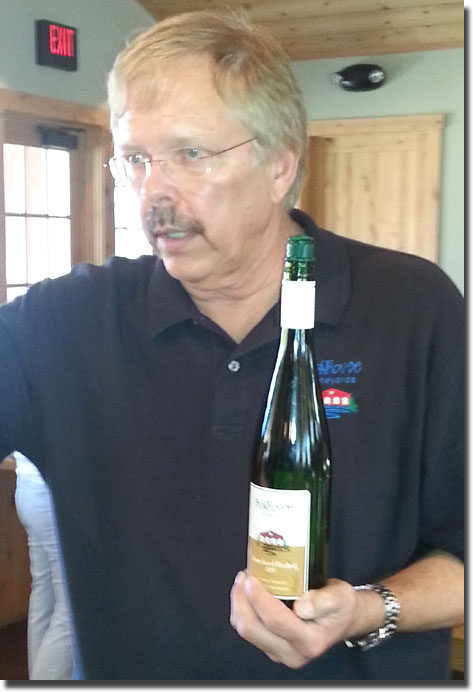 The next LPVA tour arrived while we were finishing up, so we hurriedly took our leave and motored on to our next appointment, Boathouse Vineyards, where we were greeted by owner Dave Albert (pictured on the left). My only other experience with this producer was a bottle of their excellent 2012 “Dry Dock” Riesling that I posted notes on in September of 2013. Dave expressed disbelief when I told him I’d reviewed it back then, but I have the label shot to prove it. I’d gotten it directly from Shannon (formerly known as Shawn) Walters, who made it; obviously, he gifted it to me prior to release. (Shannon had been the winemaker responsible for the wines tasted at this and the two stops that followed, but has since parted ways with French Road Cellars, the custom crush operation responsible for these and several other area wineries production.)
The next LPVA tour arrived while we were finishing up, so we hurriedly took our leave and motored on to our next appointment, Boathouse Vineyards, where we were greeted by owner Dave Albert (pictured on the left). My only other experience with this producer was a bottle of their excellent 2012 “Dry Dock” Riesling that I posted notes on in September of 2013. Dave expressed disbelief when I told him I’d reviewed it back then, but I have the label shot to prove it. I’d gotten it directly from Shannon (formerly known as Shawn) Walters, who made it; obviously, he gifted it to me prior to release. (Shannon had been the winemaker responsible for the wines tasted at this and the two stops that followed, but has since parted ways with French Road Cellars, the custom crush operation responsible for these and several other area wineries production.)
As Albert poured three wines for us, he recounted, what to me, is a familiar story. “This is way more than a hobby,” he said, adding, “I had no idea what I was getting myself into.” His gets his biggest pleasure from working in the vineyards, leaving the winemaking to French Road. He started us on the ’12 “Dry Dock,” which preformed pretty much as I remember it from my previous encounter.
2012 Boathouse “Dry Dock” Riesling: Mineral driven, correct and appealing. Find this wine
2013 Boathouse Semi-Sweet Riesling: Pretty, fruit forward nose leads to nice red and green apple flavors and zippy acids. Double Gold at the Finger Lakes International Wine Competition. Find this wine
2013 Boathouse Northern Lights Riesling: The sweetest of these three, but not excessively so (and Dave wouldn’t have it any other way), with good acids. Find this wine
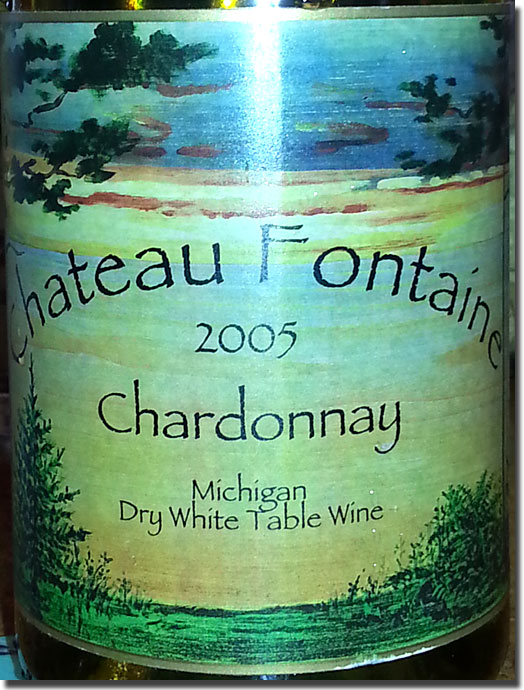 It’s always fun to visit Dan and Lucie Matthies at Chateau Fontaine Vineyard and Winery, and the wines are always quite tasty. Dan is so passionate about his wines, he can get carried away and stray from the program, so we tasted plenty more than just Riesling on this occasion.
It’s always fun to visit Dan and Lucie Matthies at Chateau Fontaine Vineyard and Winery, and the wines are always quite tasty. Dan is so passionate about his wines, he can get carried away and stray from the program, so we tasted plenty more than just Riesling on this occasion.
2013 Chateau Fontaine Riesling: Classic Michigan Riesling; green and red apple flavors and aromas laced with mineral and great acids. Find this wine
2013 Chateau Fontaine Semi-Sweet Riesling: Kicks things up a notch from the previous selection in terms of ripeness. Find this wine
2012 Chateau Fontaine Semi-Sweet Riesling: Developing some nice complexities with time in the bottle; still several fine years ahead for this one. Find this wine
2013 Chateau Fontaine Woodland White: Dan’s version of Auxerrois (see my recent report of Bel Lago’s 2012 and 2013 models); this has always been a nice wine, vintage in and vintage out, and my only note reads, “As good as I’ve ever tasted.” Find this wine
2013 Chateau Fontaine Viognier: Dan says this was never quite what he wanted it to be until he got some advice from a French visitor in the trade a few years ago who told him the vines needed to be cropped to about 1-1 ½ tons per acre. Pretty fruit, with nice balance and acids. Find this wine
2012 Chateau Fontaine Pinot Blanc: I liked this when I reviewed it almost two years ago, and it’s more than holding its own. A very nice expression of the variety. Double Gold and Best of Class at the 2013 Michigan Wine Competition. Find this wine
2013 Chateau Fontaine Gruner Veltliner: A little more fruit forward than I’m used to from Gruner, but nice. Find this wine
2013 Chateau Fontaine Chardonnay: Nicely balanced, with good acids; the pretty fruit speaks for itself, due to the use of neutral barrels. Find this wine
2005 Chateau Fontaine Chardonnay: I heard from at least one person on another of the day’s tours that Dan sprang this oldie-but-goodie on them too, and they were just as impressed as we were. Not just still alive, but showing good fruit with underlying mineral and good acids. The surprise of the day, for sure! Find this wine
2013 Chateau Fontaine Pinot Gris: Balanced and appealing. Find this wine
2013 Chateau Fontaine Woodland Red: All toasty oak and red fruit; medium full bodied, and structured for at least a few years in the cellar, especially if the following wine is any indication. Find this wine
2011 Chateau Fontaine Woodland Red: The toned-down oak is fully integrated, making for a nice, easy drinking Michigan red. Find this wine
Our final visit of the day was at Susan and Bill Braymer’s Laurentide Winery. It’s one of the newer Leelanau Peninsula wineries, and they’ve hit the ground running. I’m most familiar with their Sauvignon Blancs, so I was looking forward to tasting what they were doing with Riesling. (Pictured below; this taster, Pam Gonzalez and Amy Sherman at Laurentide.)
2012 Laurentide Riesling, $16.99: Correct and pleasant; somewhat austere, with good acids. Find this wine
2013 Laurentide Riesling, $NA: Sourced from the same block as the ’12; considerably riper and more expressive than the previous vintage, with good acids and length. Find this wine
2012 Laurentide Emergence White, $14.99: A white blend with a Riesling component and pretty aromatics. Moderately fruit forward, but not “sweet,” per se. Soft, with moderate complexity and decent acids. Find this wine
2012 Laurentide Semi-Sweet Riesling, $17.99: Pleasant, fairly ripe, with good varietal character and more than enough acidity to keep things moving along nicely. Find this wine
Once we got back to the lodge, I went straight to my room for a 15-minute power nap, and that did the trick. I returned to the first floor to join in at the wine reception taking place and to sample some goodies provided by the kitchen and member wineries.
As mentioned earlier, one of the advantages of staying at the Leland Lodge was the opportunity to not only reconnect with friends and acquaintances, but to meet new people as well. Besides those mentioned earlier, I enjoyed getting to know food blogger Kristin Celeste Shroeger and her partner Pete Edwards. Kristin’s blog, The Intentional Minimalist, focuses on “farm-to-table recipes to encourage cooking in harmony with the seasons using local and sustainable produce.” I just know she’d love to try some of Kim’s wonderful wine and malt vinegars.
I also enjoyed meeting and talking with Robb and Kate Harper, of edibleWOW Magazine, which “celebrates the local chefs, farmers, and food & beverage artisans of Southeastern Michigan.” Likewise, with Stephanie Schlatter, whose artwork graces the walls of both Michigan By The Bottle Tasting Rooms and a few Michigan wine labels. The same goes for Michigan food and wine author Sharon Kegerreis.
I had been corresponding with L. Mawby Marketing Manager Dayna Valpey for some time, so it was a real pleasure to finally meet her in person. I’m not at all surprised that we got on famously, given that we have so many similar interests.
The Leland Lodge is a wonderful location for this event, and I can’t say enough good things about Events Coordinator Melissa Mateling, who attended to our every need on Friday night and all day Saturday. Kudos also to sommelier Nate Cole, who is so accommodating, and only too willing to converse at length about one of our favorite subjects, wine!
Finally, many thanks to the Leelanau Peninsula Vintners Association for staging this terrific annual event, among many others, and for inviting us back again. Director Lorri Hathaway and staff do a wonderful job of promoting the wines and wineries of the peninsula.
Like I said, I love hanging out in Leland.
Every month is Michigan Wine Month.
Reporting from Day-twah,
Bastardo
Related posts:
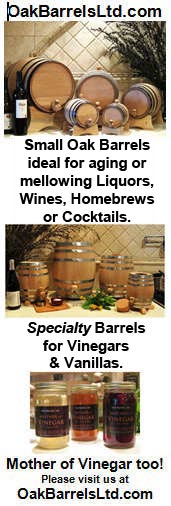




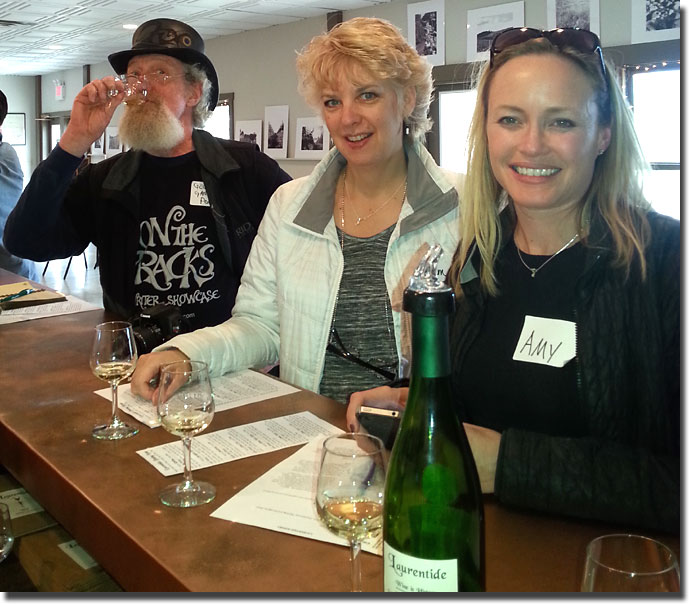
[...] up on two recent Riesling reports (here and here), we decided to expand our focus on the variety beyond our home state and try some from [...]
Geo, you really captured not only the essence of media weekend (and there were some superb essences) but the details of a wonderful serial wine experience. Tasting on the Pinot trail was also superb. Great snapshot notes, and the fresh smelt at Bluebird was tasty, wasn’t it? Memories of dipping in Au Gres as a kid….
The organizational efforts of Lorri Hathaway and her team, the hospitality and generosity of the vintners, and the hosting at Leland Lodge by Melissa and her staff combined for another extremely fun and educational event. Michigan wines are simply SO GOOD. And the passion of the proprietors and winemakers is so evident.
Cheers, Mike
Thanks for the kind words, Mike, I appreciate them immensely! I agree with you on all the points you make. More Riesling and more smelt!